LEXUS LS430 2006 Owners Manual
Manufacturer: LEXUS, Model Year: 2006, Model line: LS430, Model: LEXUS LS430 2006Pages: 419, PDF Size: 11.19 MB
Page 281 of 419
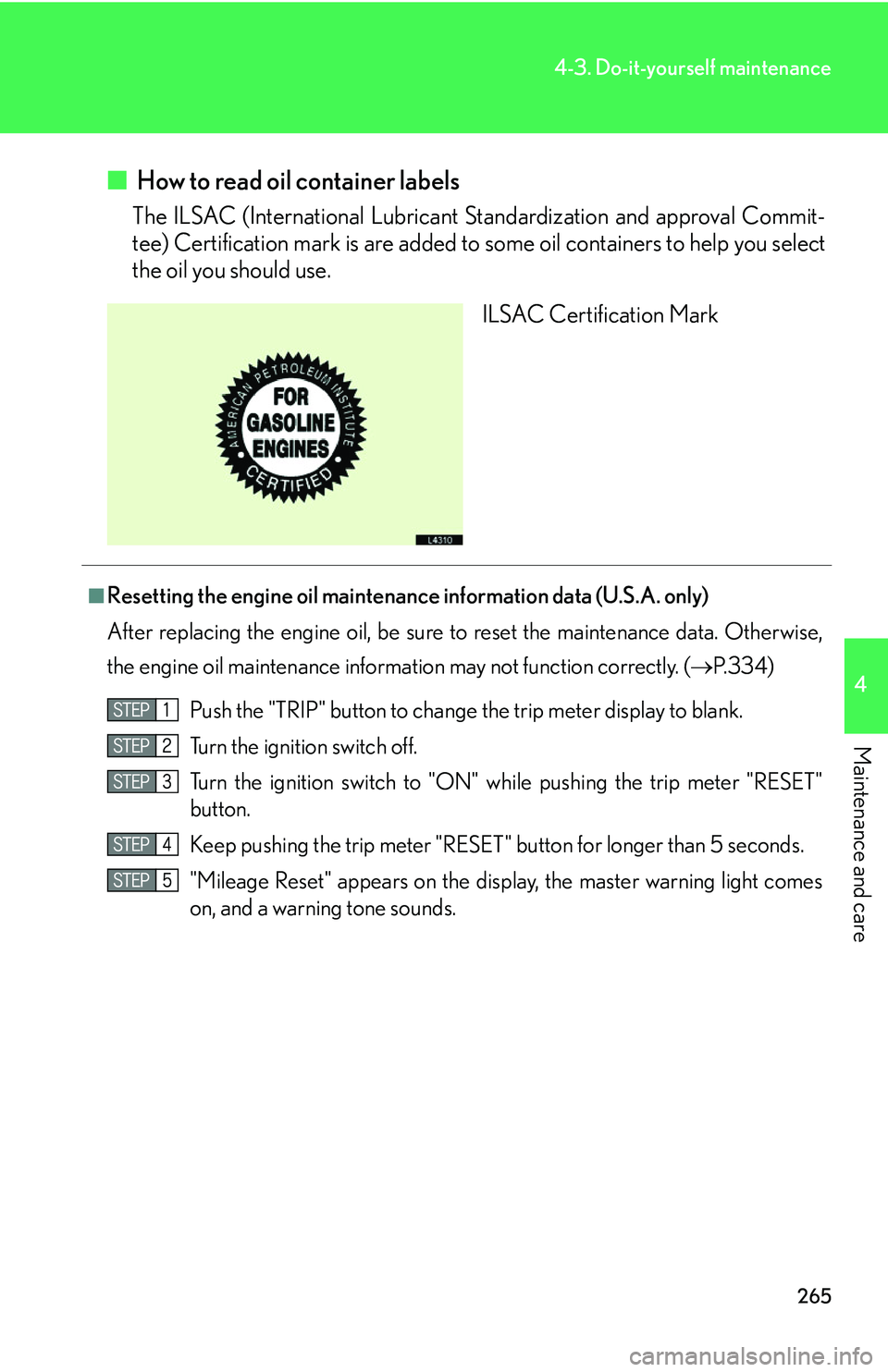
265
4-3. Do-it-yourself maintenance
4
Maintenance and care
■ How to read oil container labels
The ILSAC (International Lubricant Standardization and approval Commit -
tee) Certification mark is are added to some oil
containers to help you select
the oil you should use.
ILSAC Certification Mark
■Resetting the engine oil maintenance information data (U.S.A. only)
After replacing the engine oil, be sure to
reset the maintenance data. Otherwise,
the engine oil maintenance information may not function correctly. ( P.334 )
Push the "TRIP" button to change t
he trip meter display to blank.
Turn the ignition switch off.
Turn the ignition switch to "ON" while pushing
the trip meter "RESET"
button.
Keep pushing the trip meter "RESET " button for lon
ger than 5 seconds.
"Mileage Reset" appears on
the display, the master warning light comes
on, and a warning tone sounds.
Page 282 of 419
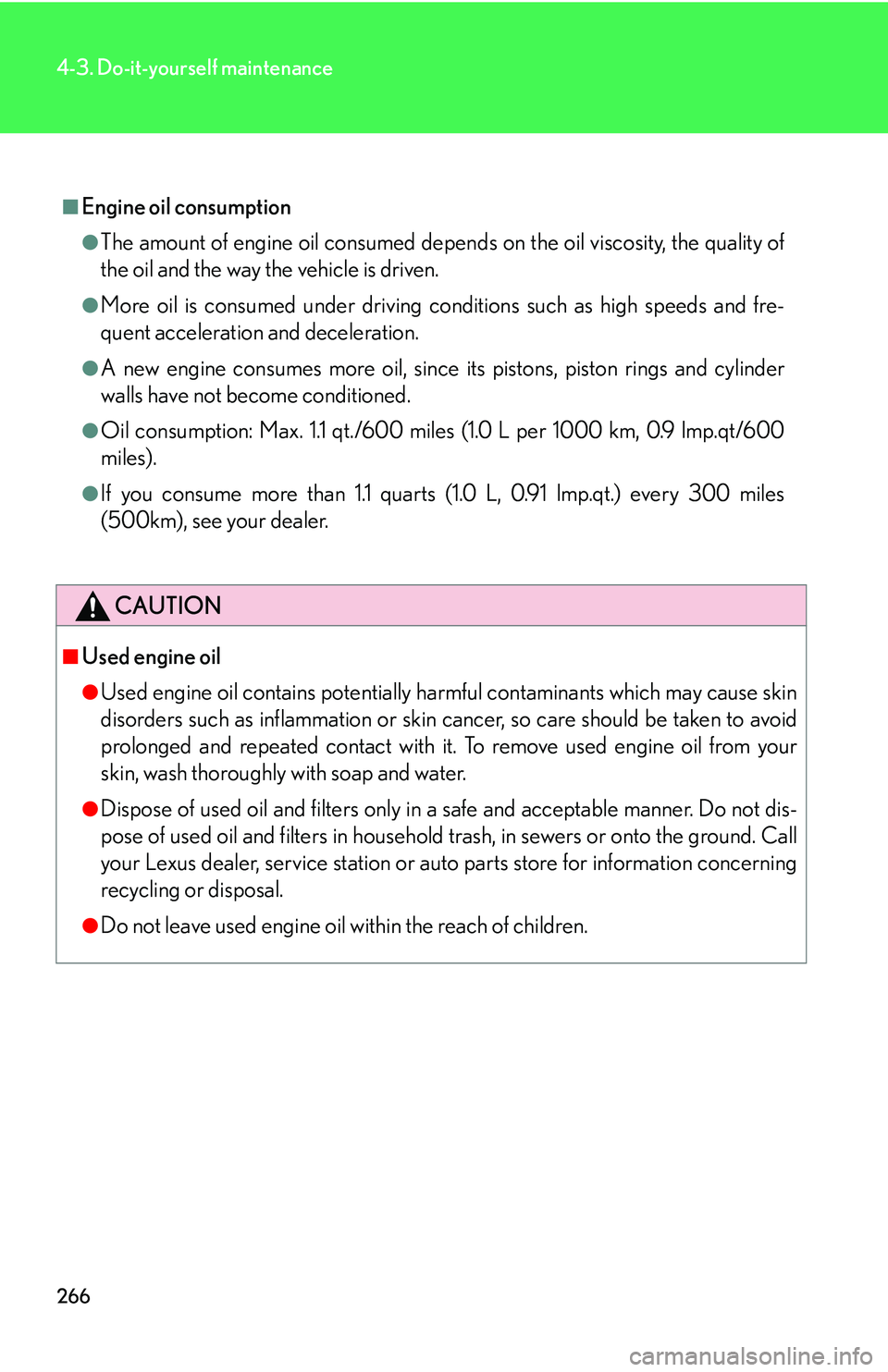
266
4-3. Do-it-yourself maintenance
■Engine oil consumption
●The amount of engine oil consumed depends on the oil viscosity, the quality of
the oil and the way the vehicle is driven.
●More oil is consumed under driving conditions such as high speeds and fre -
quent acceleration and deceleration.
●A new engine consumes more oil, since its pistons, piston rings and cylinder
walls have not become conditioned.
●Oil consumption: Max. 1. 1 qt./600 miles (1.0 L per 1000 km, 0.9 lmp.qt/600
miles).
●If you consume more than 1.1 quarts (1.0 L, 0.91 lmp.qt.) every 300 miles
(500km), see your dealer.
CAUTION
■Used engine oil
●Used engine oil contains potentially harmful contaminants which may cause skin
disorders such as inflammati on or skin cancer, so care should be taken to avoid
prolonged and repeated contact with it. To remove used engine oil from your
skin, wash thoroughly with soap and water.
●Dispose of used oil and filters only in a safe and acceptable manner. Do not dis -
pose of used oil and filters in household trash, in sewers or onto the ground. Call
y
our Lexus dealer, service station or auto parts store for information concerning
recycling or disposal.
●Do not leave used engine oil within the reach of children.
Page 283 of 419

267
4-3. Do-it-yourself maintenance
4
Maintenance and care
NOTICE
■To prevent serious engine damage
Check the oil level regularly.
■When replacing the engine oil
●Be careful not to spill engine oil on the vehicle components.
●Avoid overfilling, or the engine could be damaged.
●Check the oil level on the dipstick every time you refill the vehicle.
●Be sure the engine cap is properly retightened.
Page 284 of 419
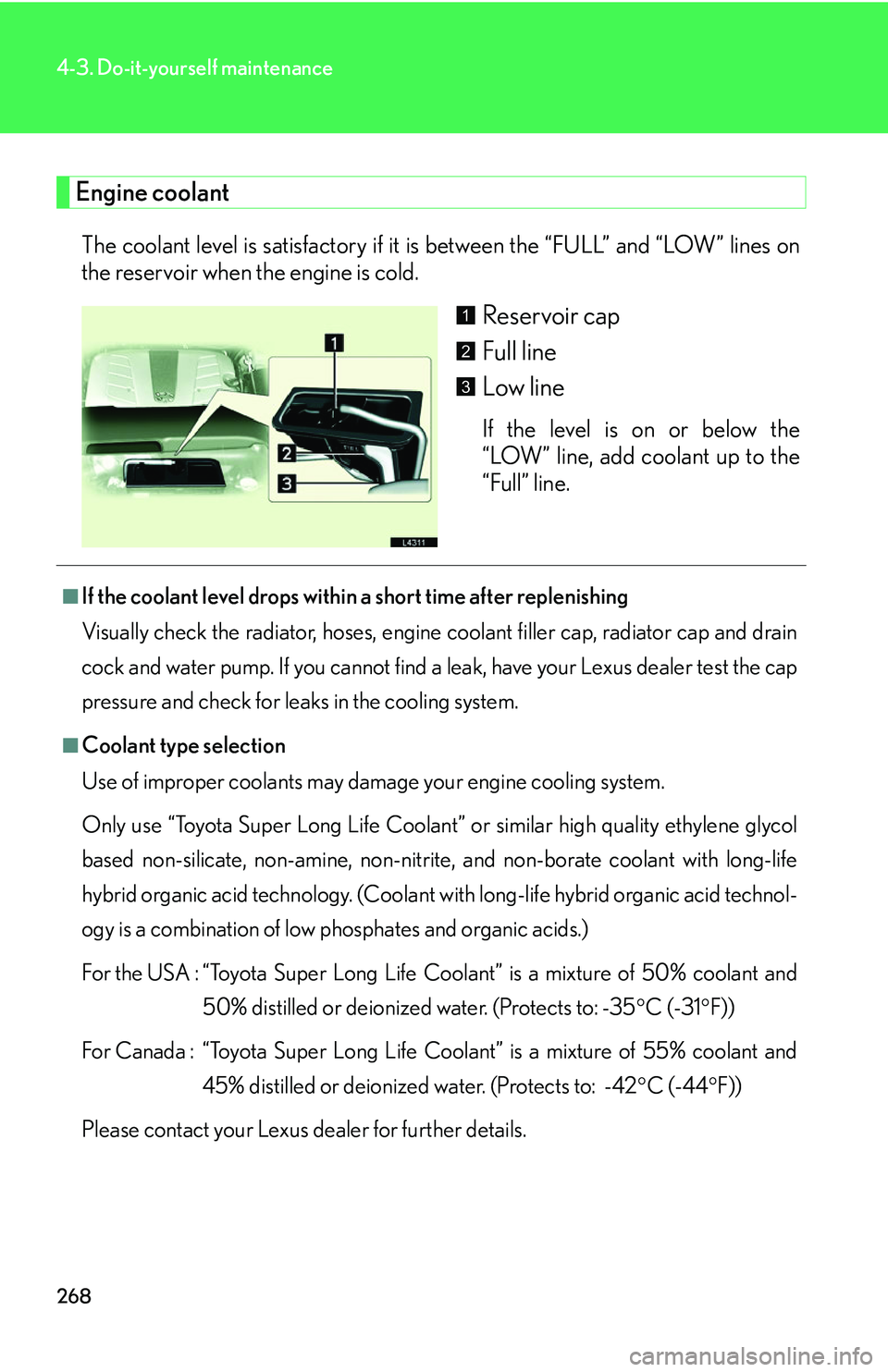
268
4-3. Do-it-yourself maintenance
Engine coolant
The coolant level is satisfactory if it is between the “FULL” and “LOW” lines on
the reservoir when the engine is cold.
Reservoir cap
Full line
Low line
If the level is on or below the
“LOW” line, add coolant up to the
“Full” line.
1
2
3
■If the coolant level drops within a short time after replenishing
Visually check the radiator, hoses, engine c
oolant filler cap, radiator cap and drain
cock and water pump. If you cannot find a leak, have your Lexus dealer test the cap
pressure and check for leaks in the cooling system.
■Coolant type selection
Use of improper coolants may dama ge y
our engine cooling system.
Only use “Toyota Super Long Life Coolant” or similar hig
h quality ethylene glycol
based non-silicate, non-amine, non-nitrite, and non-borate coolant with long-life
hybrid organic acid technology. (Coolant wi th long-life hybrid organic acid technol-
ogy is a combination of low phosphates and organic acids.)
For the USA : “Toyota Super Long Life Coolant” is a mixture of 50% coolant and 50% di
stilled or deionized water. (Protects to: -35 C (-31F))
For Canada : “Toyota Super Long Life Coolant” is a mixture of 55% coolant and 4
5% distilled or deionized water. (Protects to: -42 C (-44F))
Please contact your Lexus dealer for further details.
Page 285 of 419
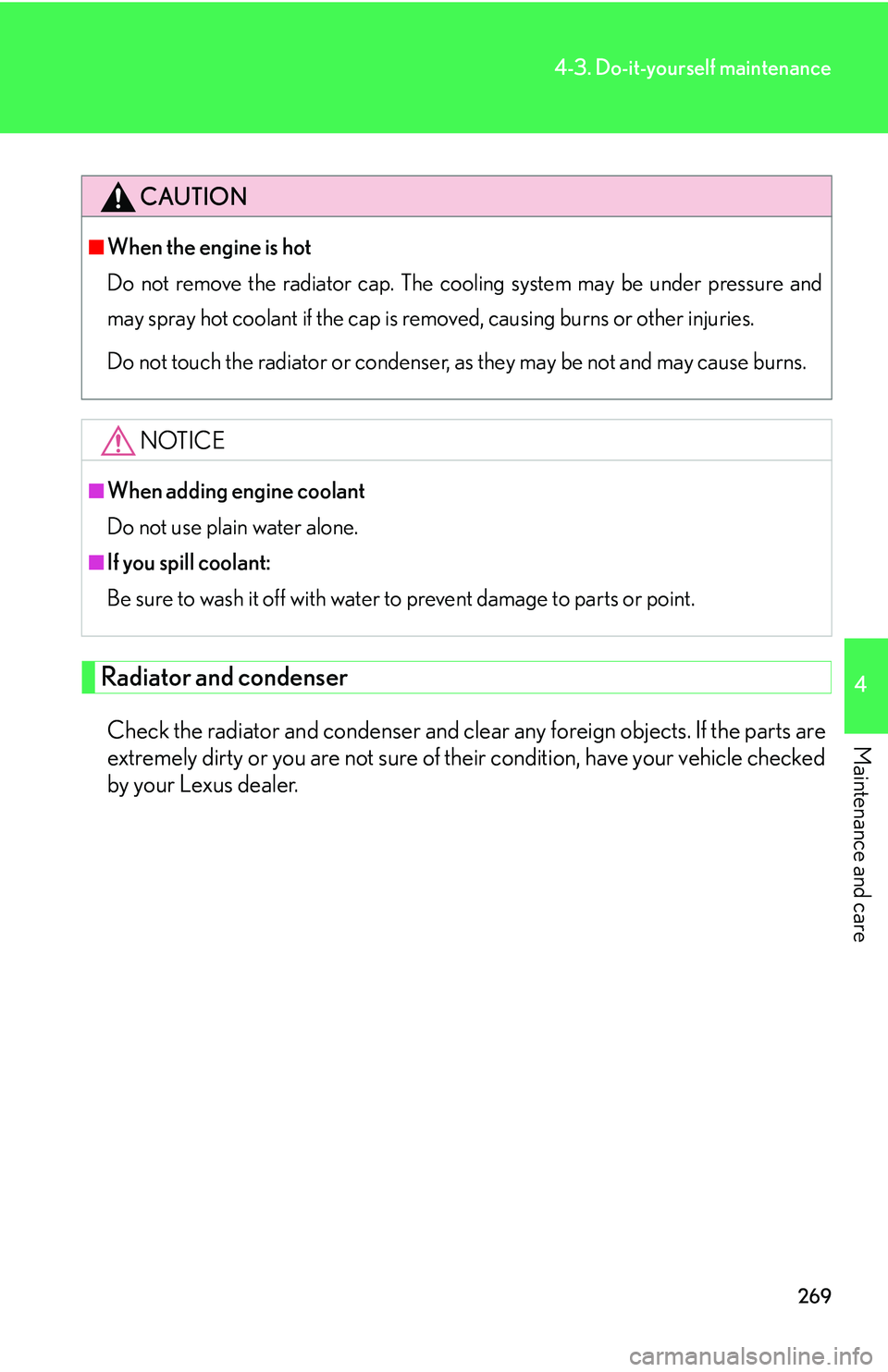
269
4-3. Do-it-yourself maintenance
4
Maintenance and care
Radiator and condenser
Check the radiator and condenser and clear any foreign objects. If the parts are
extremely dirty or you are not sure of their condition, have your vehicle checked
by your Lexus dealer.
CAUTION
■When the engine is hot
Do not remove the radiator cap. The cooling system may be under pressure and
ma
y spray hot coolant if the cap is removed, causing burns or other injuries.
Do not touch the radiator or condenser, as they may be not and may cause burns.
NOTICE
■When adding engine coolant
Do not use plain water alone.
■If you spill coolant:
Be sure to wash it off with water to prevent damage to parts or point.
Page 286 of 419
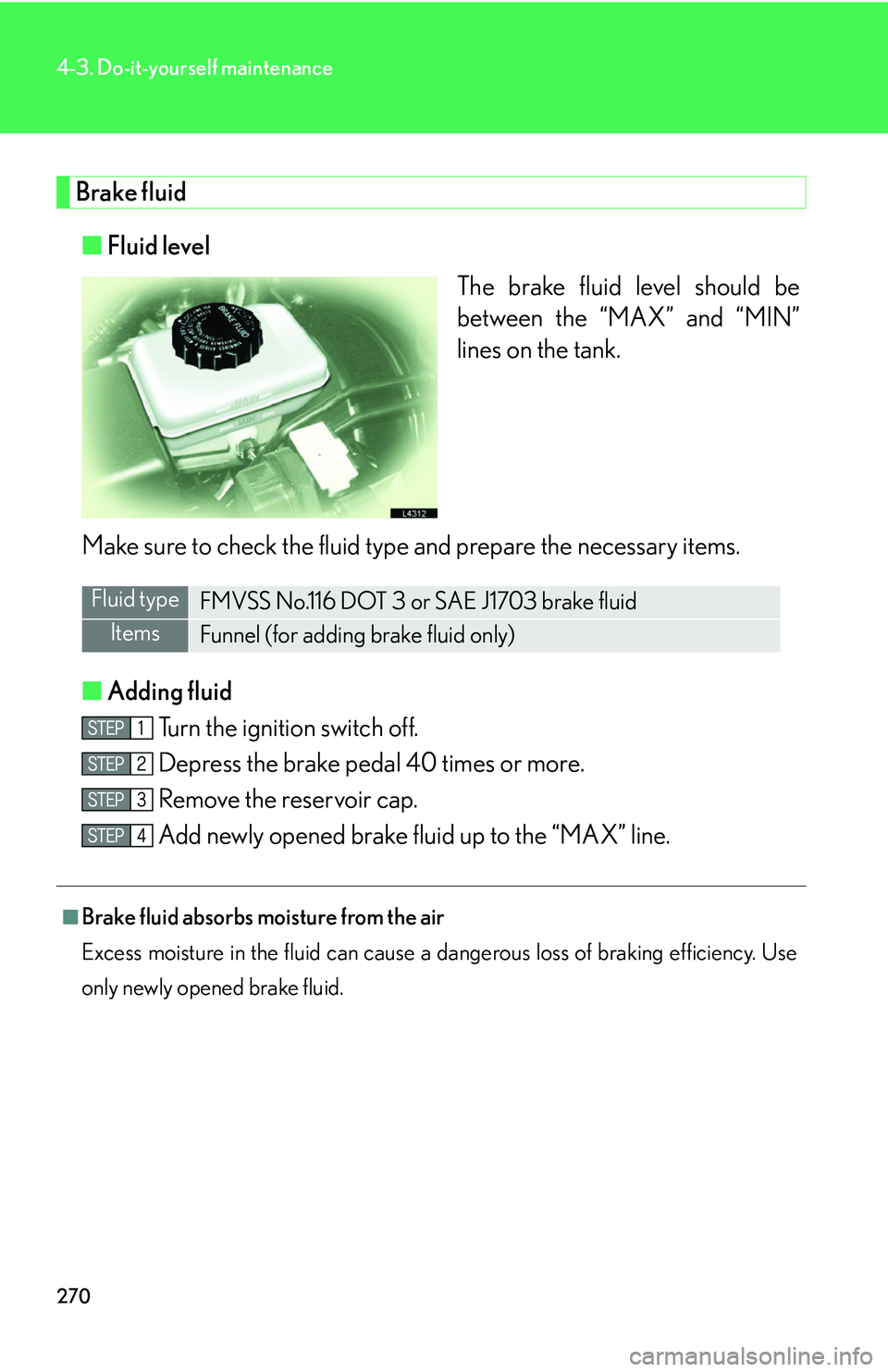
270
4-3. Do-it-yourself maintenance
Brake fluid
■Fluid level
The brake fluid level should be
betw
een the “MAX” and “MIN”
lines on the tank.
Make sure to check the fluid type and prepare the necessary items.
■ A
dding fluid
Turn the ignition switch off.
Depress the brake pedal 40 times or more.
Remove the reservoir cap.
Add newly opened brake fluid up to the “MAX” line.
Fluid typeFMVSS No.116 DOT 3 or SAE J1703 brake fluid
ItemsFunnel (for adding brake fluid only)
■Brake fluid absorbs moisture from the air
Excess moisture in the fluid can cause a dangerous loss of braking efficiency. Use
o
nly newly opened brake fluid.
Page 287 of 419
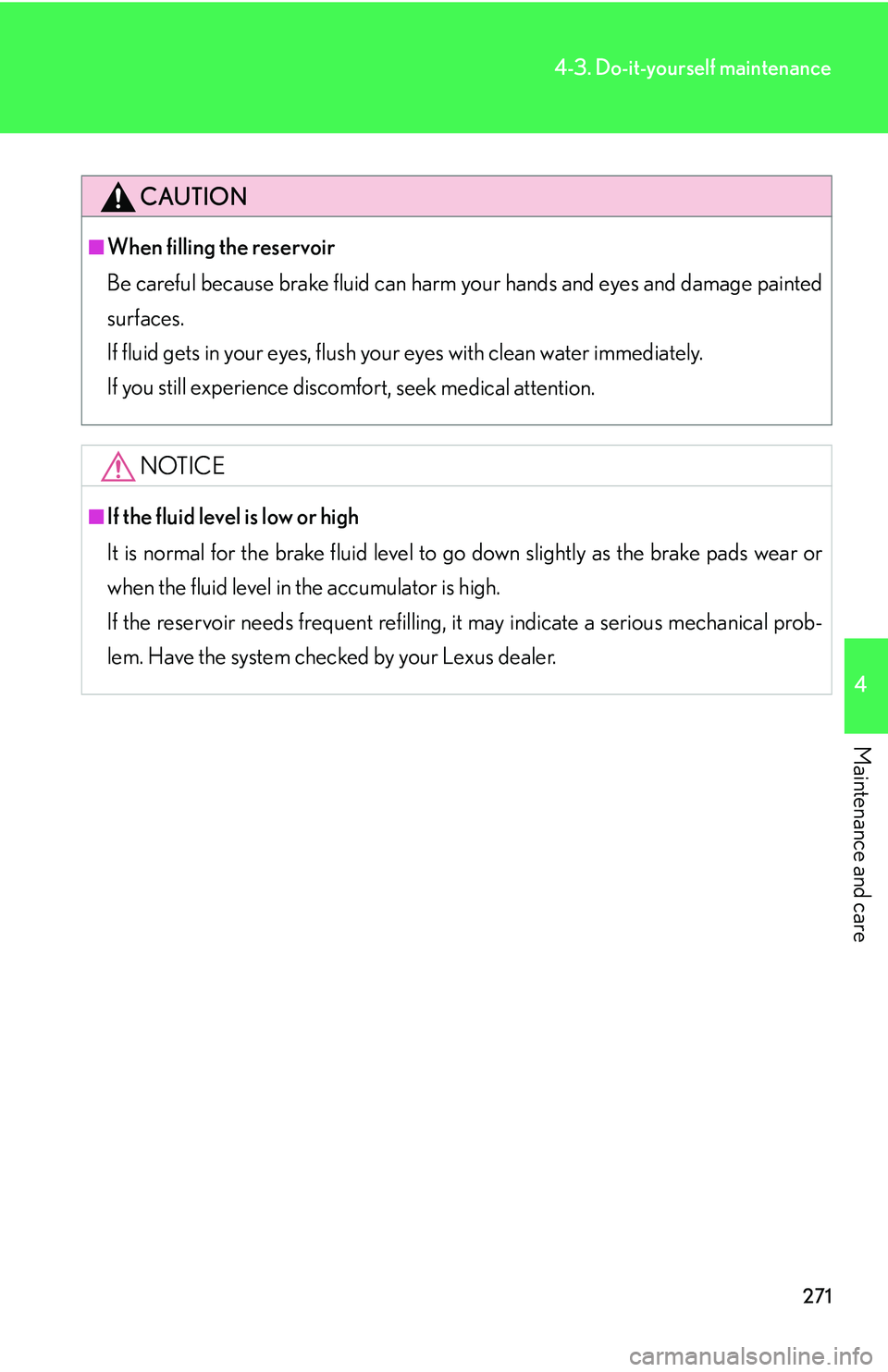
271
4-3. Do-it-yourself maintenance
4
Maintenance and care
CAUTION
■When filling the reservoir
Be careful because brake fluid can harm your hands and eyes and damage painted
sur
faces.
If fluid gets in your eyes, flush your eyes with clean water immediately.
If you still experience discom for
t, seek medical attention.
NOTICE
■If the fluid level is low or high
It is normal for the brake fluid level to go down slightly as the brake pads wear or
whe
n the fluid level in the accumulator is high.
If the reservoir needs frequent refilling, it may indicate a serious mechanical prob -
lem. Have the system checked by your Lexus dealer.
Page 288 of 419
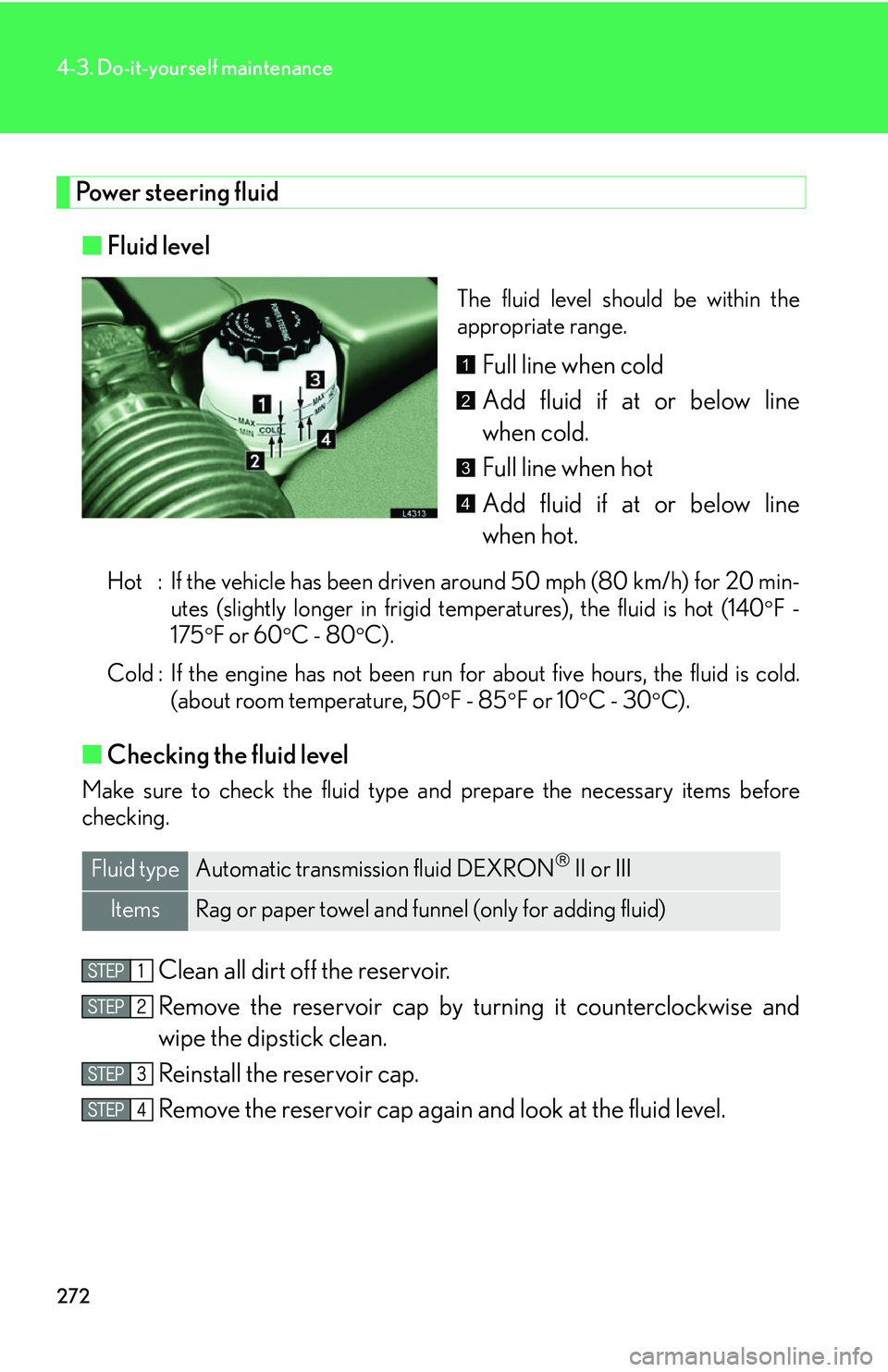
272
4-3. Do-it-yourself maintenance
Power steering fluid
■Fluid level
The fluid level should be within the
appropriate range.
Full line when cold
Add fluid if at or below line
when cold.
Full line when hot
Add fluid if at or below line
when hot.
Hot : If the vehicle has been driven around 50 mph (80 km/h) for 20 min -
utes (slightly longer in frigid te mper
atures), the fluid is hot (140F -
175
F or 60C - 80C).
Cold : If the engine has not been run for about
five hours, the fluid is cold.
(about room temperature, 50
F - 85F or 10C - 30C).
■ Checking the fluid level
Make sure to check the fluid type and prepare the necessary items before
checking.
Clean all dirt off the reservoir.
Remove the reservoir cap by tu rning it counter
clockwise and
wipe the dipstick clean.
Reinstall the reservoir cap.
Remove the reservoir cap again and look at the fluid le
vel.
1
2
3
4
Fluid typeAutomatic transmission fluid DEXRON II or III
ItemsRag or paper towel and funnel (only for adding fluid)
Page 289 of 419
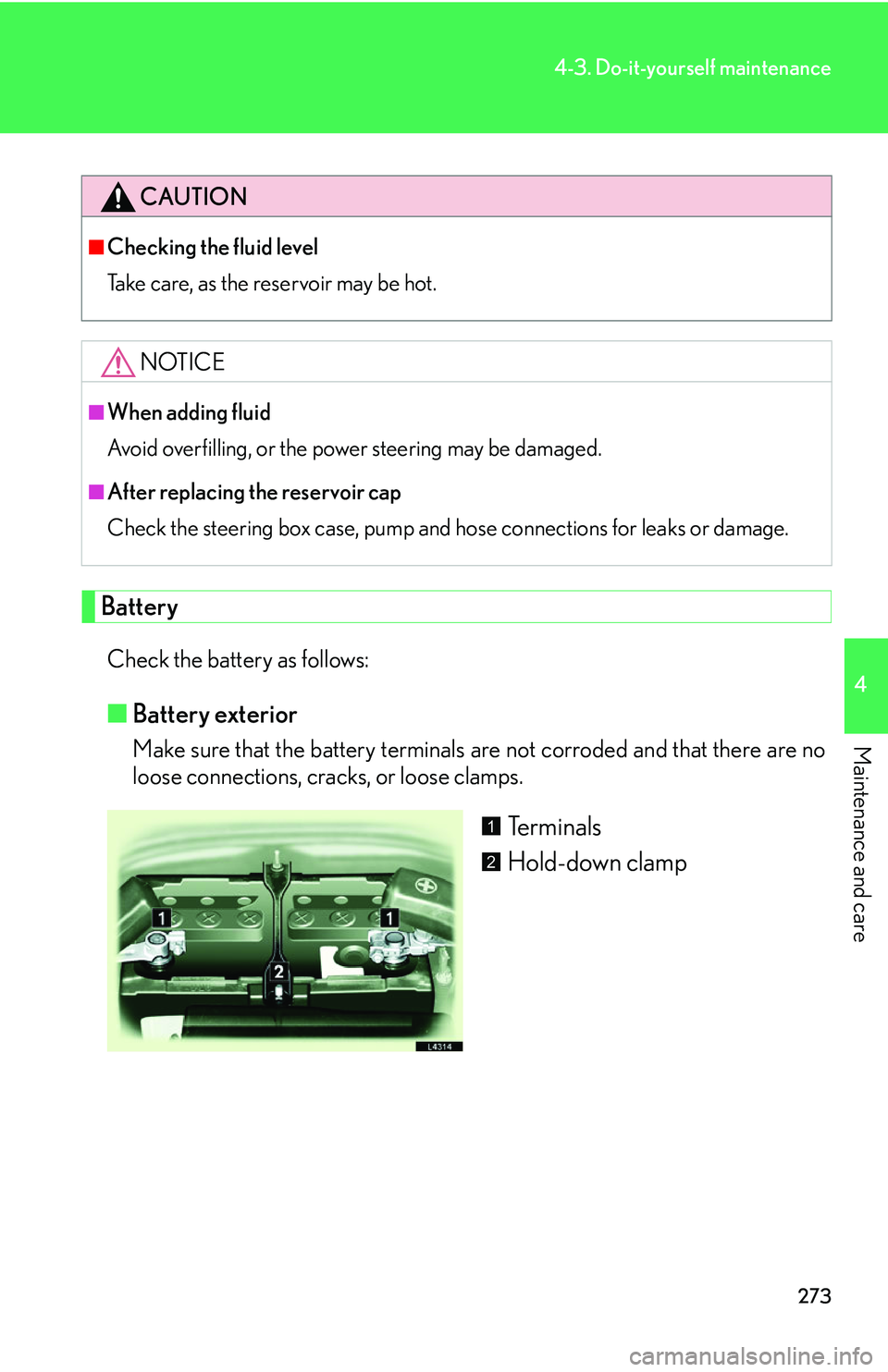
273
4-3. Do-it-yourself maintenance
4
Maintenance and care
Battery
Check the battery as follows:
■Battery exterior
Make sure that the battery terminals are not corroded and that there are no
loose connections, cracks, or loose clamps.
Terminals
Hold-down clamp
CAUTION
■Checking the fluid level
Take care, as the reservoir may be hot.
NOTICE
■When adding fluid
Avoid overfilling, or the po w
er steering may be damaged.
■After replacing the reservoir cap
Check the steering box case, pump and ho
se connections for leaks or damage.
1
2
Page 290 of 419
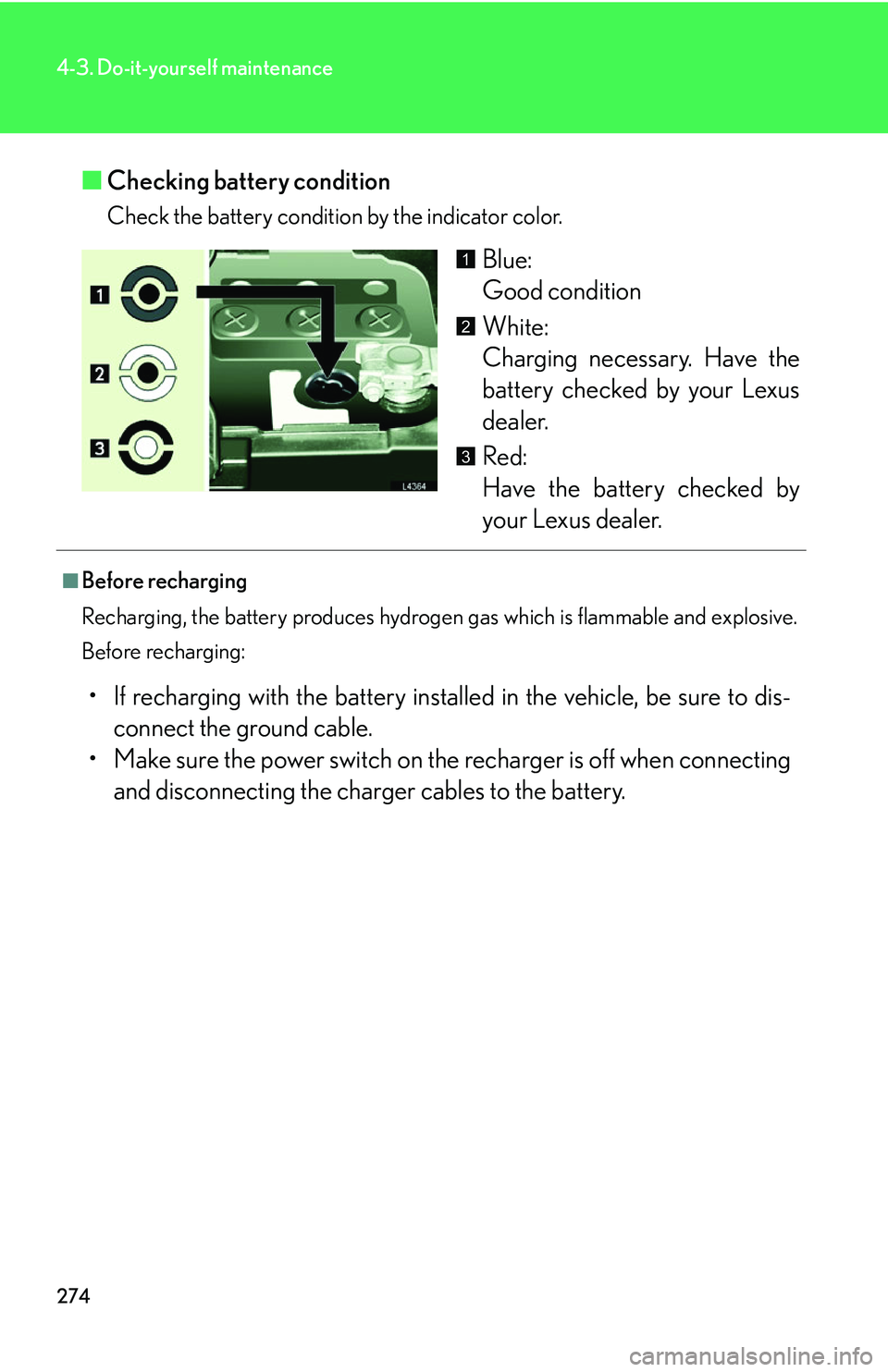
274
4-3. Do-it-yourself maintenance
■Checking battery condition
Check the battery condition by the indicator color.
Blue:
Good condition
White:
Charging necessary. Have the
batter
y checked by your Lexus
dealer.
Red:
Have the battery checked by
y
our Lexus dealer.
1
2
3
■Before recharging
Recharging, the battery produces hydrogen gas which is flammable and explosive.
Be
fore recharging:
• If recharging with the battery installe d in the vehicle, be sure to dis-
connect the ground cable.
• Make sure the power switch on th e r
echarger is off when connecting
and disconnecting the char ger cables to the battery.